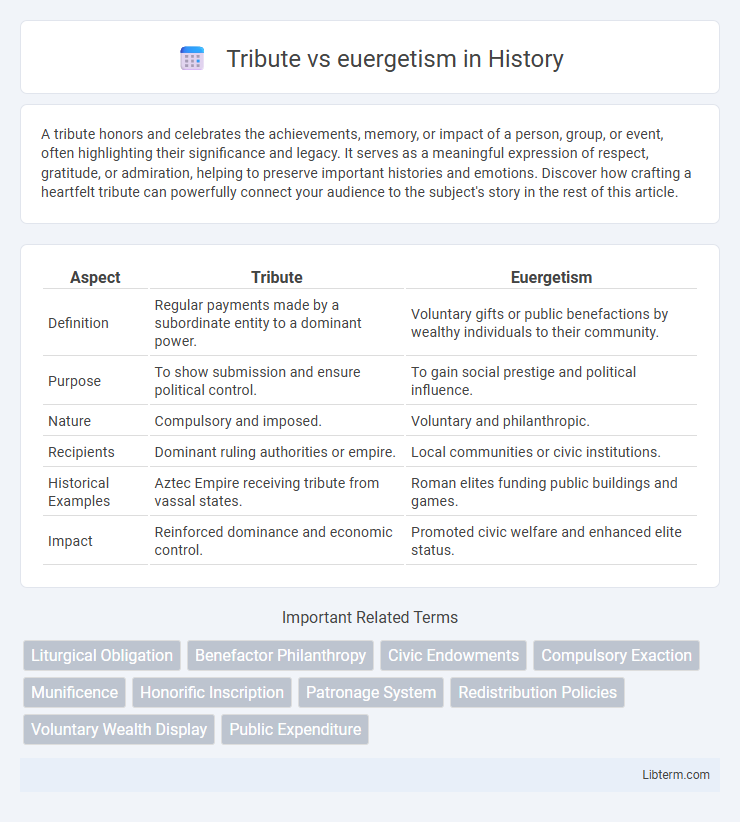A tribute honors and celebrates the achievements, memory, or impact of a person, group, or event, often highlighting their significance and legacy. It serves as a meaningful expression of respect, gratitude, or admiration, helping to preserve important histories and emotions. Discover how crafting a heartfelt tribute can powerfully connect your audience to the subject's story in the rest of this article.
Table of Comparison
| Aspect | Tribute | Euergetism |
|---|---|---|
| Definition | Regular payments made by a subordinate entity to a dominant power. | Voluntary gifts or public benefactions by wealthy individuals to their community. |
| Purpose | To show submission and ensure political control. | To gain social prestige and political influence. |
| Nature | Compulsory and imposed. | Voluntary and philanthropic. |
| Recipients | Dominant ruling authorities or empire. | Local communities or civic institutions. |
| Historical Examples | Aztec Empire receiving tribute from vassal states. | Roman elites funding public buildings and games. |
| Impact | Reinforced dominance and economic control. | Promoted civic welfare and enhanced elite status. |
Understanding Tribute and Euergetism
Tribute is a systematic payment made by a subordinate entity to a dominant power, often symbolizing submission or political allegiance in ancient empires. Euergetism refers to the practice of wealthy individuals distributing wealth or public goods voluntarily to communities to gain social prestige and political influence. Understanding tribute highlights formal, obligatory transfers, whereas euergetism emphasizes voluntary generosity with social reciprocity in ancient societies.
Historical Origins of Tribute
Tribute originates from ancient civilizations such as Mesopotamia and Egypt, where it served as a formal acknowledgment of submission and a source of economic resources for empires. Unlike euergetism, which involves voluntary elite donations to communities, tribute was typically extracted through coercion or as a result of conquest. The practice of tribute reinforced hierarchical power structures and facilitated imperial control over subjugated regions.
The Evolution of Euergetism
Euergetism evolved from the practice of tribute as city-states and rulers shifted from demanding obligatory payments to voluntarily sponsoring public works and social welfare, enhancing their status and influence. This transformation marked a move towards reciprocal relationships where elites gained prestige by funding temples, infrastructure, and festivals, reflecting the changing political and social dynamics of ancient societies. The evolution of euergetism is evident in Greek and Roman contexts, where patronage became a crucial tool for consolidating power and fostering civic identity.
Key Differences Between Tribute and Euergetism
Tribute involves compulsory payments or goods extracted by a dominant power from a subordinate group, reflecting a formalized system of political control and subjugation. Euergetism describes voluntary acts of wealthy individuals distributing resources for public benefits, enhancing their social prestige without coercion. The key difference lies in tribute's obligatory nature enforced by authority, contrasting with euergetism's philanthropic motivation rooted in social reciprocity.
Political Motivations Behind Tribute
Tribute functioned as a formalized system where political leaders extracted wealth to reinforce state power and legitimize their authority, often compelling subordinate groups to acknowledge dominance. Unlike euergetism, which involved voluntary elite contributions to public goods to gain social prestige and political support, tribute was primarily coercive and instrumental in maintaining hierarchical control. Political motivations behind tribute centered on resource redistribution to sustain military campaigns, administrative structures, and political alliances within empires and city-states.
Social Functions of Euergetism
Euergetism, unlike tribute which is compulsory, operates as voluntary elite benefaction contributing to public welfare and urban development, fostering social cohesion and political legitimacy. Wealthy patrons fund infrastructure, festivals, and public services, enhancing their prestige and reinforcing hierarchical social structures through reciprocal obligations. This practice strengthens community bonds by redistributing wealth in socially recognized forms, supporting civic identity and collective well-being.
Economic Impacts of Tribute Systems
Tribute systems redistributed wealth through compulsory payments from subjugated regions, often centralizing resources for imperial elites while suppressing local economies. Euergetism involved voluntary elite donations to communities, stimulating local economic activity by funding public works and social services. The economic impact of tribute systems frequently resulted in extractive economies and social stratification, whereas euergetism fostered communal wealth circulation and infrastructure development.
Euergetism as a Tool for Social Prestige
Euergetism, the practice of wealthy individuals funding public works or events, served as a strategic tool for social prestige by visibly demonstrating their generosity and reinforcing their elite status within the community. Unlike tribute, which often implied subjugation or payment imposed by authority, euergetism was a voluntary act that cultivated reciprocal relationships and social capital among citizens. This public benefaction enhanced honor and influence, securing political power and social recognition in ancient societies.
Case Studies: Tribute vs Euergetism in Ancient Civilizations
Case studies in ancient civilizations reveal distinct patterns between tribute and euergetism as mechanisms of wealth transfer and power consolidation. In the Roman Empire, conquered provinces paid tribute as mandatory financial exactions reinforcing imperial control, while prominent elites engaged in euergetism by funding public works to gain social prestige and political influence. Similarly, the Aztecs extracted regular tribute from subjugated city-states to sustain their empire, whereas affluent rulers practiced euergetism by sponsoring temples and festivals, reinforcing elite authority and communal loyalty.
Modern Legacies of Tribute and Euergetism
Modern legacies of tribute manifest in contemporary tax systems where states extract resources from citizens to fund public goods and infrastructure, reflecting ancient practices of obligatory contributions to central authorities. Euergetism's legacy persists in philanthropic traditions and corporate social responsibility, where voluntary wealth redistribution supports community projects, mirroring elite sponsorship of public amenities in antiquity. Both mechanisms influence modern governance and social cohesion by balancing compulsory and voluntary resource allocation.
Tribute Infographic

 libterm.com
libterm.com